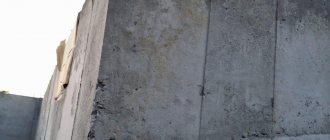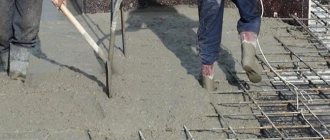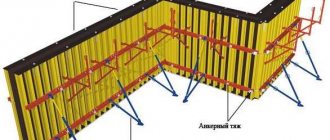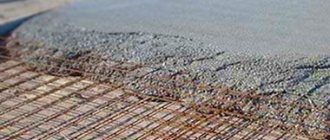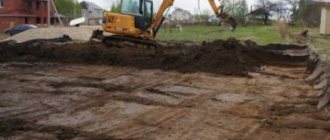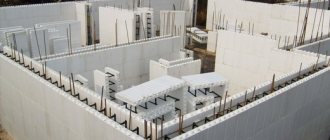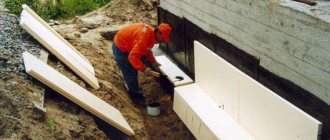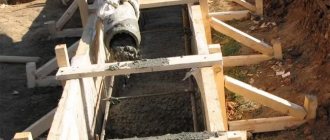The construction of any building, industrial, commercial or residential, or any domestic buildings requires the laying of a foundation. It still needs to sit well and settle before starting to lay out the walls and other construction activities. So between the initial stage and other work there is quite a long time.
The soil influences how long it will take, how the foundation will behave during the operation of the house, and whether the building will settle. Soils are heterogeneous, watery, often compress, and collapse under such serious loads. It was for the uniform distribution of physical pressure from above that preparation for the foundation was invented. Sand, concrete, crushed stone, gravel cushion are also designed to reduce building subsidence and other deformations due to natural causes.
When is concrete preparation required?
The footing is a layer of thin cement laid between a layer of gravel or crushed stone and the body of the foundation. As a rule, the thickness of the pillow does not exceed 1 dm.
Thanks to it, the building rests securely on a stable foundation. This is what is most lacking in these situations:
- loose soils;
- existence of seismic hazard;
- close proximity to slopes, slopes and embankments;
- high compressive load from the building.
In addition to the basic purpose - a strong support for the structure - foundation preparation facilitates many stages of the process:
- Installation of prefabricated structures on a leveled surface is more convenient, and the results are accurate.
- High-grade concrete is consumed more economically when it is laid out on a flat, compacted base made of cheap material.
- On concrete it is easier to install a frame of reinforcement with maximum precision to make a monolithic foundation. A crushed stone cushion will not give such an accurate result.
- A special coating is created that prevents the penetration of moisture.
- Protection of concrete from loss of grade due to leakage of cement laitance, complete hydration of binder grains.
Purpose of preparation for the foundation
Large-scale buildings and massive structures require preparation for a foundation. This stage of the construction of the main structure of the building is carried out for the following purposes:
- Leveling – levels the bottom of the trench as much as possible. The sub-base is necessary for slab and prefabricated foundations. If you plan to lay a shallow shallow foundation under a low building, then gravel or compacted sand will play the role of a cushion.
- Drainage is the removal of precipitation to the side and preventing the rise of moisture from deep layers.
- Protection against shifts - seasonal soil movement. A good layer of gravel or sand can provide reliability to the base, which stabilizes weak and heaving soils.
- Protection against frost heaving - during cold weather the ground freezes, the frost reaches the groundwater, it turns into a solid state, increasing in size. Expanding water pushes the foundation out of the ground, and the footing successfully prevents this.
- To avoid shrinkage of the building, a strong support under the object will not allow the building to settle due to natural and other reasons.
- Achieving building stability - prevents the negative consequences of tremors, advisable in seismologically unstable areas.
As for frost heaving, the soil cannot cope with this phenomenon; a denser base is needed here. Freezing of clay soils in winter is uneven, their volumes sometimes increase up to 9%. In addition, throughout the cold season, clay gradually draws moisture from the lower horizons. Then the rise of the soil will be very noticeable, and the scale of deformation will exceed the building area and reach the road and railway track.
What is a footing and why is it needed?
The concrete footing performs several useful functions at once:
- Creates waterproofing of the foundation, increases its durability. Protects against groundwater and prevents moisture from passing further. Liquid cement mortar will not leak through this layer of concrete, and the base will not crack when drying due to the uniform distribution of moisture over the surface.
- Reduces the cost of cement-sand mortar. For the footing, an inexpensive concrete mixture is used - BZ.5-B7.5, which reduces the overall cost of the project.
- Provides a flat surface for the rough concrete base. On a straight site it is easier to make markings, set up reinforcement, attach beacons, prefabricated formwork, thanks to this the quality and speed of work increases.
- Eliminates shrinkage of the building.
- Increases the strength of the structure - foundation + reinforced concrete.
Which concrete preparation for the foundation is better?
Under a monolith or block foundation, a pillow is installed in one of two ways:
- Pouring a 10-centimeter layer of low-grade concrete M50–M100.
- Laying crushed stone, filling with liquid bitumen.
Most often, the footing differs from other similar preparations in that it is a widening of the foundation. Stretching the area of the load-bearing surface is necessary if the calculated width of the foundation wall is not enough to support the weight of the future house. The expanded base will support much more weight and will serve as a reliable support. The thickness of the footing in this case should be at least 300 mm, but not more than 400 mm.
According to building regulations, during the manufacture of a concrete pad the following points must be taken into account and fulfilled:
- lean concrete is prepared from grade M50;
- the thickness of the pillow is 10 cm;
- the mixture is poured onto a sand-crushed stone bed;
- the poured mass needs to rest for 28 days;
- when drawing up a project and directly laying the base for the foundation, it is necessary to take into account the type of soil, the load from the object, the location of nearby buildings, the level of seismic threat and the degree of environmental friendliness of the materials;
- For the frame, cold-deformed type reinforcement (d=3-12mm), reinforced 6–40 mm or hot-rolled (d=3-80 mm) is used.
Calculating the load is a mandatory step in the event of soil compression during winter frosts, the placement of a house on a hill or slope, or the location of the sole on an unstable surface.
Technology for constructing a foundation slab from A to Z
The foundation is an integral part of any construction of houses or buildings. If it is done incorrectly, the erected structure may soon begin to deform or even collapse. The choice of foundation type depends on the type of structure, as well as the type of soil on the site, and if the soil is heaving, then a foundation slab is most often used. It is a fairly reliable foundation for a building, but quite often construction companies demand unheard-of sums for its construction, which reach a third of the cost of the building. But everything is not as bad as it might seem at first glance; you can make a slab foundation yourself.
Technology of concrete preparation for the foundation
This technology is not often used in ordinary residential construction, since the activities are quite labor-intensive and expensive. But it is precisely this that is considered the most durable among bases made from other compositions. Concrete preparation is arranged according to the same principle as the foundation of a building, only the layer will be several times thinner.
Filling the pillow consists of the following steps:
- Excavation.
- Laying and compacting the sand layer.
- Waterproofing device.
- Pouring a thin layer of cement.
- Construction of formwork.
- Laying out a horizontal reinforcing layer.
- Pouring a concrete pad.
- Bayoneting.
- Drying.
By adhering to this particular order of work, it is possible to guarantee the building’s resistance to earthquakes, soil erosion, soil freezing, sliding and subsidence of the foundation. With such preparation, the likelihood of cracks in the foundation, destruction of the house and failures is significantly reduced. The footing retains moisture in the solution that has not yet hardened. If water seeps into the soil, the hardening process is unlikely to proceed correctly, and the properties of concrete will not be fully revealed.
Regulations.
What regulatory documents and rules must the installation of concrete preparation for the foundation meet?
When carrying out industrial and civil construction, the construction of any types of structures is subject to special provisions given in industry and state standards, building codes and regulations, as well as codes of practice. The main documentation regulating the specifics of the work is:
- SNiP 52–01, issued in 2003, deals with structures made of concrete and reinforced concrete;
- SP 50–101, approved in 2004, containing requirements for the design and construction of foundation foundations;
- SP 52–101 (2003), devoted to structures without prestressed reinforcement;
- SNiP 2.02.01, developed in 1983, regulating the parameters of the foundations of construction projects;
- SP 63.13330.2012 is a set of rules that combines requirements for building structures.
These standards clearly define the features of activities related to the construction of foundations and their design. They take into account:
- Soil characteristics at the construction site.
- Specifics of the development object.
- Environmental requirements.
- Actionable efforts.
- Degree of seismic activity.
The requirements of regulatory documents are subject to strict compliance by construction companies and organizations carrying out design work.
Concrete preparation for strip foundation.
The construction of any structures during the construction of civil and industrial facilities is subject to certain requirements.
Preparatory activities
At this stage, it is important to form a good construction site for the foundation. It is necessary to properly treat the soil to ensure a tight fit to the base of the structure, because it is entrusted with the task of holding the entire structure.
Sequencing:
- Digging a pit along the width of the building.
- Cleaning the bottom of stones, debris and plant roots.
- Tamping the surface for compaction.
- Depending on the activities carried out further, the soils are moistened or dried.
Preparing a pit or trench
The foundation pit is prepared in advance, before the concrete is poured. Digging is done manually if a private house is being built. Pit parameters:
- As for the shapes: for a columnar foundation you will need wells or pits, for a strip trench, and a rectangular pit is suitable for a tiled base.
- The depth is selected according to the level of soil freezing (30–40 cm below the mark) and the height of groundwater rise (you cannot approach closer than 0.5 m).
- The width and length of the pit should exceed the dimensions by 15–20 cm on each side.
Creating a pillow from sand or crushed stone
Sand preparation is used quite often, mainly for strip foundations. When laying, it is important to take into account the compaction of sand, so its level should be 15% higher. It is better to take coarse sand: river or quarry.
A sand cushion under the foundation has many advantages:
- accessible material, unlimited reserves of sand are available in almost all regions;
- sand compacts well;
- it absorbs groundwater and removes rain from the foundation, preventing it from being washed away;
- sand perfectly absorbs frost heaving;
- the sand cushion prevents the penetration of cold and retains heat;
- savings when creating a base layer;
- distributes loads evenly;
- allows you to level the surface;
- the work is so simple that you can do it yourself;
- dense and durable pillow.
A layer of crushed stone under the foundation will be a more durable alternative to sand. Limestone crushed stone will not work here; it is better to take granite or gravel. In most cases, the base is covered with gravel; it is cheaper.
The crushed stone cushion differs from the sand cushion in its increased cost, lower ability to absorb moisture, and greater strength. Such a foundation will support both two and three-story buildings. Frost-resistant varieties of crushed stone can also be found on the market today.
Varieties
Sand pillow
This pad is suitable for areas with wet soil.
The construction of a foundation on such material optimally distributes the impact of the soil. This version of the concrete footing is constructed in mid-spring or autumn, when the soil stops seasonal movement. When using this type of preparation, the bottom of the load-bearing base rises above the level of soil water, so the concrete structure avoids the destructive influence of ground moisture. This type of foundation cushion is used on soils with high humidity. The thickness of the layer is set within 15 cm.
To make a sand substrate you need a material with the following characteristics:
- Fraction 2-2.5 mm. The most suitable sand is low density, capable of good moisture permeability.
- Clay particles, limestone, salt deposits. Minor presence is allowed.
- Organic particles. They contribute to the formation of silt, which impedes the water-carrying capacity of the concrete base.
The construction of the substrate is carried out according to the following algorithm:
To lay the pillow you need to dig a pit.
- The soil under the pit is removed.
- The bottom of the trench is filled with prepared sand.
- The material is leveled over the pit, the uniformity of the backfill is controlled by the level.
- The pillow is being compacted.
Crushed stone footing
To lay the material, a pit is prepared, 200-600 mm deep. If there is high groundwater in the area, the bottom is covered with film material. Laying begins with a backfill of coarse gravel, then fine gravel. This sequence will provide the foundation structure with constant drainage. This will increase the strength and rigidity of the substrate. The structure is covered with sand, which will ensure uniform transfer of the weight of the structure to the laid layers. This type of concrete footing is unreliable; it does not have a sufficient level of rigidity, which is why multi-storey buildings are not suitable for this purpose. Small-sized and outbuildings can be built on such a bedding.
The mechanism for arranging foundation preparation includes the following stages:
The stone cushion should be placed at the bottom of the pit.
- The excavation is prepared and crushed stone is laid.
- The material is leveled with shovels.
- Crushed stone is compacted over the entire base area.
- The hydraulic barrier is made from a bitumen mixture or film-roll material.
Such activities can be carried out on your own. If hired workers are involved, the required payment for the volume of work performed can be compared with the available information in EniR.
Construction from profile membranes
Polymer membranes, which recently appeared on the construction market, are used in this type of work as a means of waterproofing. Fiber protects the building from rising moisture from the soil. The profile with spikes at the same time strengthens the soil, and this is a fundamentally new property of such materials.
Manufacturers note the beneficial properties of geomembranes:
- reduce the likelihood of formation and number of cracks during shrinkage;
- redistribute forces when transferring load to the base;
- ventilate voids between insulation and concrete;
- water is guaranteed not to leak due to the section of a certain shape;
- are distinguished by durability and strength;
- able to withstand temperatures that are too high or too low.
The fiber is laid on a layer of geotextile on an already formed sand-crushed stone. preparation before concrete is poured.
Requirements for the calculation part
Building rules require calculation of the forces that the foundation can absorb in the following cases:
- In the presence of severe compressive forces.
- When the construction site is located near embankments, slopes or slopes.
- When arranging the base of the foundation located on weak soils.
The standards allow not to carry out calculations of bearing loads if, according to the project, measures will be taken that do not allow soil movement.
As forces acting on the base, the set of rules takes into account all transmitted loads, acting both short-term and throughout the entire period of operation. The mass of the part of the object below the zero mark is also taken into account.
Making lean concrete with your own hands
Lean concrete is a so-called lightweight version of the material, which contains only 6% cement, and in addition, crushed stone or gravel fillers are introduced. The smallest number of components guarantees instant setting, production and hardening of the composition.
Making your own skinny concrete requires a little effort. For 275 kg of cement you need 590 kg of sand and 165 liters of water. This amount will fill 1 m² of base.
Sand and gravel are introduced gradually into a concrete mixer with cement and water, sometimes water is added. Following the results of mixing, liquid plasticizers are introduced, and the mixing time of the composition should not exceed 5 minutes.
Concrete preparation (pouring)
The general picture of preparing a concrete pad for the foundation will look like this:
- Forming the bottom of a trench or pit.
- Backfilling with coarse or medium crushed stone. Leveling and compacting the layer, in the end it should be 10–15 cm thick.
- Next, coarse sand is added, moistened and compacted.
- Installation of fittings and vertical outlets for connection with the base.
- Pouring a decimeter layer of cement, leveling, compacting, releasing air from the thickness of the material.
- Removing the formwork panels after a week or less.
It is advisable to strengthen the foundation of any building with a concrete pad or any other preparation for the foundation. Its type must be chosen based on many design features, soil and other criteria. Construction standards prescribed in special documents must not be neglected. The exact calculation and quality of the material cannot be overlooked either. The result should be a solid foundation for the foundation of a capital building. Read about concreting a strip foundation yourself here
Calculation of cement mortar
The process of making concrete footings
After marking the area planned for the installation of a sub-concrete protective layer for the foundation, the work is carried out in the following order:
- A pit or trench is dug, depending on what type of foundation is planned for the device.
- Crushed stone is poured into the bottom of the prepared pit, after which the layer is compacted. The thickness of the crushed stone layer is on average about 10 cm.
- Formwork panels are being installed. The height of the shields should be at the level of the planned filling layer; this will simplify the leveling process and allow the reinforcing frame to be correctly placed.
View of the prepared site for pouring lean concrete
- Horizontal reinforcement is laid. Typically, periodic steel bars with a diameter of 8 mm are used. You can simplify the process by using special cards of construction reinforcing mesh.
- Vertical reinforcement rods are installed, protruding 20 - 30 cm beyond the edge of the formwork. These rods will allow you to connect the concrete footing to the base of the building. Sometimes vertical bars are installed in poured and compacted concrete.
- The filling composition is mixed. The cement binder used when mixing the solution is cement grade M50 or more.
- The finished solution is poured into the formwork and compacted using mechanical vibrators.
